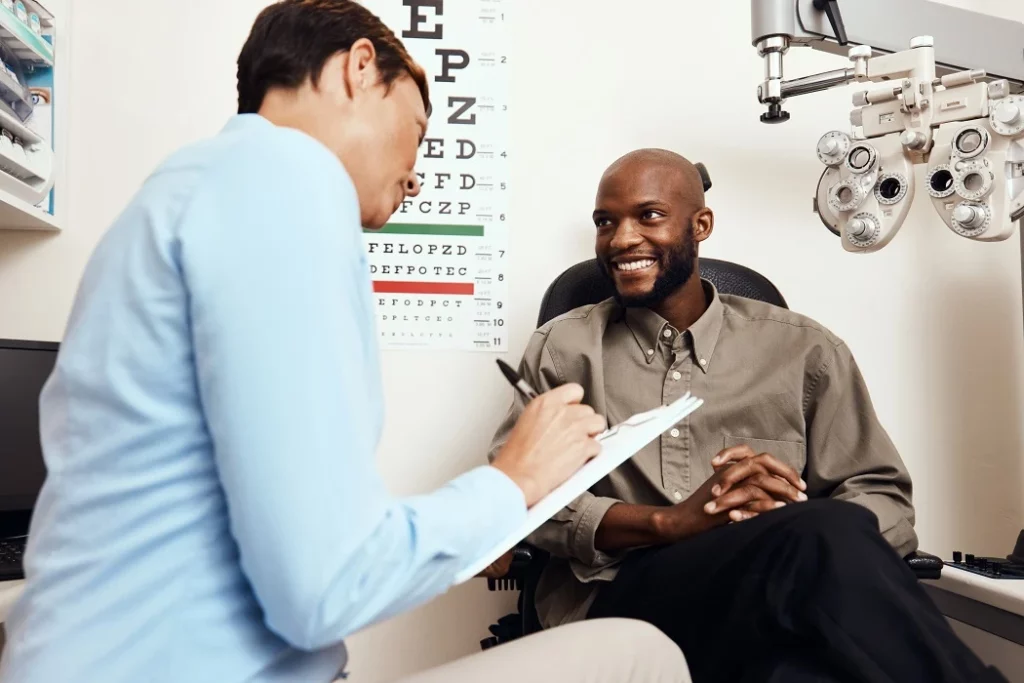9 Common Types of Eye Tests
What Are the Different Types of Eye Exams?
Your eyes are the gateway to the world around you, guiding you through life’s experiences. Whether you’re admiring a breathtaking sunset or tackling your daily routines, your vision is an invaluable asset. This highlights the significance of regular visits to the eye doctor. At Discover Vision Centers, we prioritize your eye health and offer routine eye exams to keep your vision as sharp as possible.
Ever wondered about the diverse range of vision tests incorporated into a comprehensive eye examination? Let’s learn the various types of eye testing available.
What Constitutes an Eye Exam or Vision Test?

An eye exam encompasses a series of vision tests used by a healthcare professional to assess the well-being of your eyes. Beyond merely determining your eyeglass or contact lens prescription, the primary focus of a comprehensive eye exam is the overall health of your eyes.
These exams are crucial in the early detection of serious vision issues like cataracts and macular degeneration. In addition to vision tests, discussions about recent vision changes are an integral part of the examination, offering you the opportunity to seek clarifications and ensure optimal vision health.
9 Common Types of Eye Tests
When it comes to evaluating your eye health and vision, many tests can be used. These tests are designed to assess different aspects of your eyes, ranging from visual acuity to peripheral vision. Let’s explore the details of each of these eye examinations:
#1. Visual Acuity Test
The basic eye exam (“Snellen Eye Chart” test), is where you identify letters on a chart at a distance to determine the clarity of your vision.
#2. Visual Refraction Eye Test
Refraction involves the bending of light waves when they traverse your cornea and lens. This is a crucial assessment to determine if you need vision correction as well as the specific prescription for corrective lenses that’ll give you the most clarity and sharpness in your vision.
During this examination, your eye doctor may employ a phoropter, a specialized device designed to aid in identifying your refractive error. This assessment typically occurs in a dimly lit room, enhancing your ability to perceive images through the phoropter’s lenses more clearly. This process is repeated several times to pinpoint the precise lenses that can provide you with the optimal lens prescription for your best visual acuity.
#3. Visual Field Tests
This examination checks your peripheral vision by prompting you to identify objects or lights that appear in your field of vision.
#4. Slit-Lamp Exam
Utilizing a microscope with intense light, this test allows for detailed examination of the cornea, iris, lens, and anterior chamber, often aided by fluorescein dye to detect irregularities.
#5. Glaucoma Test
A vital test that measures intraocular pressure to detect developing glaucoma, a potentially vision-threatening condition. Non-contact tonometry is a common method used.
#6. Color Blindness Test
This test assesses your ability to distinguish colors by identifying numbers or letters within multicolored circles.
#7. Retinoscopy
During this examination, you’ll focus on an object while your eye care provider uses a phoropter and shines light into your eyes. This helps determine the need for vision correction.
#8. Corneal Topography
Thousands of images of your cornea are taken to map its shape, aiding in the assessment of conditions like astigmatism and suitability for procedures like corneal transplant.
#9. Ophthalmoscopy (Fundoscopy)
After dilating your pupils with eye drops, this test involves shining a light into your eye to examine the retina, optic nerve, and blood vessels at the back of your eye.
Recommended Eye Examination Frequency by Age
| Age Group | Asymptomatic/Low Risk | At-Risk |
|---|---|---|
| Birth – 2 years | 6-12 months | 6-12 months or as recommended |
| Ages 3-5 | At least once between 3-5 years | At least once between 3-5 years or as recommended |
| Ages 6-17 | Before first grade and annually | Before first grade and annually thereafter or as recommended |
| Ages 18-39 | At least every two years | At least annually or as recommended |
| Ages 65 and older | Annually | At least annually or as recommended |
• How often are eye tests needed? In reality, the frequency of eye examinations for pediatric patients depends on their risk factors. For example, children with certain risk factors may require more frequent examinations based on professional judgment. Risk factors include prematurity, family history of eye conditions, maternal health during pregnancy, and more.
Patients who have undergone refractive surgery (LASIK, PRK, SMILE) should continue to have regular eye exams every 1-2 years to monitor overall ocular health. Regular eye exams are important for maintaining eye health and detecting potential issues early.



Comments
Post a Comment